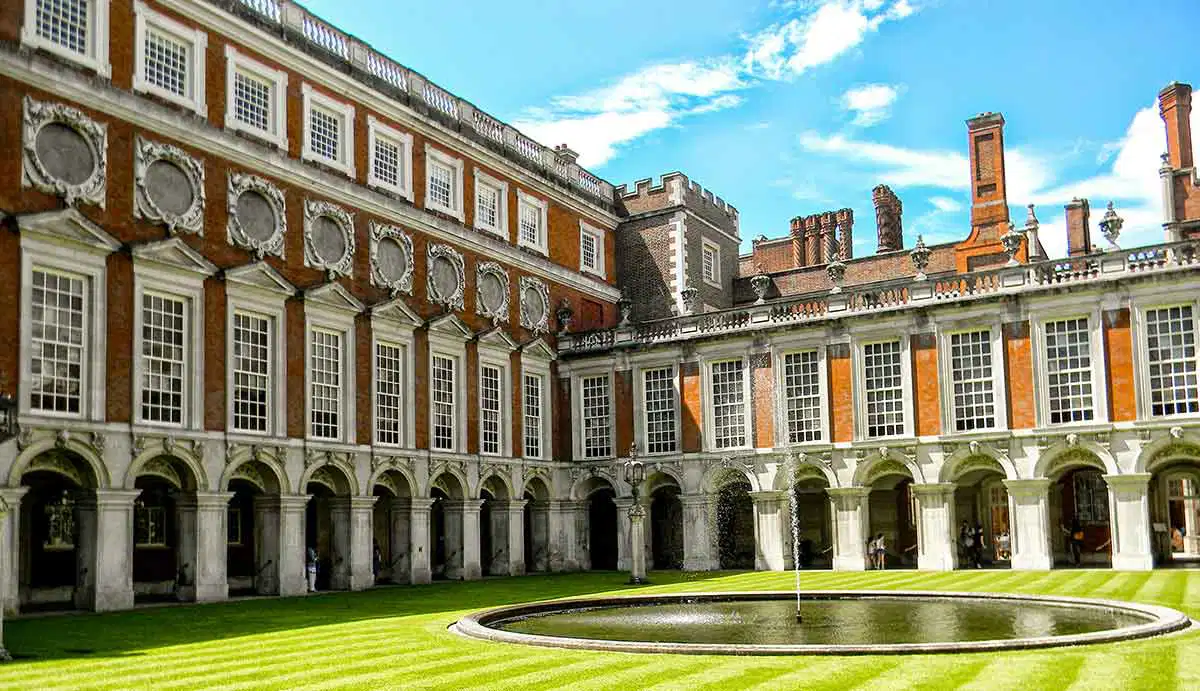Hampton Court Palace, the iconic residence of King Henry VIII, is renowned for its rich history and architectural grandeur. Yet, alongside its regal legacy, the palace is steeped in eerie tales of ghostly apparitions. From the spectral presence of Jane Seymour to the chilling screams of Catherine Howard, Hampton Court is often called one of England’s most haunted sites. But are these stories rooted in truth, or are they clever fabrications to entice visitors? Join us as we explore the palace’s history and its most famous ghost stories to uncover whether Hampton Court is truly haunted.

A Brief History of Hampton Court Palace
Located in the London Borough of Richmond upon Thames, 12 miles southwest of central London along the River Thames, Hampton Court Palace is a Grade I-listed royal residence. Managed by Historic Royal Palaces, this 16th-century masterpiece attracts around 600,000 visitors annually. The site has a history stretching back to the Bronze Age, with the Anglo-Saxon term “Hammtonne” describing its location on a river bend.
Originally transformed by Cardinal Thomas Wolsey in the early 1500s, the palace was a lavish project costing 200,000 crowns. In 1529, Wolsey gifted it to King Henry VIII to appease him after failing to secure a divorce from Catherine of Aragon. Henry and Anne Boleyn became its first royal residents, and the palace remained a royal home until King George II’s reign in the 18th century. Today, its features—like the Hampton Court maze, formal gardens, and 16th-century tennis courts—continue to captivate visitors.

The Lady in White: Jane Seymour’s Ghost
One of Hampton Court’s most enduring ghost stories centers on Jane Seymour, Henry VIII’s third wife. Jane died on October 24, 1537, just 12 days after giving birth to Edward VI, likely from puerperal fever. Her ghost, known as the Lady in White, is said to haunt the palace, appearing as a pale, blonde woman dressed in white, carrying a candle.
Sightings typically occur near the queen’s apartments, along the Silver Stick Gallery, or down the Silver Stick Stairs, where she vanishes. Occasionally, she’s spotted wandering the Clock Court, appearing lost. Described as luminous and melancholic, her presence is linked to guilt over displacing Anne Boleyn. Legend claims Jane’s spirit seeks Anne’s forgiveness, lingering until it is granted.

The Haunted Gallery and Catherine Howard
The Haunted Gallery, once called the Processional Route, is infamous for its connection to Catherine Howard, Henry VIII’s fifth wife. In 1541, accused of adultery and treason, Catherine was confined to the queen’s apartments awaiting transfer to the Tower of London. Desperate, she escaped her guards and ran to the royal chapel, where Henry was praying, screaming for mercy.
Her pleas went unanswered, and she was dragged back, executed in February 1542. Visitors today report unease in the gallery, with some hearing fleeting screams or witnessing apparitions of a young woman. The gallery is also notorious for frequent fainting spells, making it the palace’s most medically eventful area. These phenomena have cemented its reputation as a paranormal hotspot.

Sibell Penn and the Spinning Wheel
Sibell Penn, a lesser-known Tudor figure, served as a nurse to Edward VI and Elizabeth I. Chosen by Thomas Cromwell for her skill, she was devoted to the royal children, especially Elizabeth. In 1562, while nursing Elizabeth through smallpox, Sibell contracted the disease and died. She was buried in a church at Hampton Court, and a marble effigy was erected in her honor.
In 1829, the church’s demolition disturbed her tomb, and soon after, residents reported strange noises from the palace’s southwest wing, resembling thread spinning and a female voice. Investigations uncovered a hidden room containing a spinning wheel and a worn stool. The noises ceased after the discovery, leading many to believe Sibell’s spirit had returned to her old room. Since 1890, sightings of her ghost have made her one of Britain’s best-documented apparitions.
[block id=”related”]
The Huntress and the Hound: Anne of Denmark and Jewel
Anne of Denmark, wife of King James I, was known as England’s Huntress Queen for her love of deer hunting in Richmond Park. She and James shared a turbulent marriage but bonded over hunting, often accompanied by their dog, Jewel, James’s beloved pet. During a hunt, Anne accidentally shot and killed Jewel, mistaking him for a deer.
James, though furious, forgave Anne, even sending her a 2,000-pound diamond as a gesture. Legend claims Jewel’s ghost roams Richmond Park, his howls echoing on the anniversary of his death, searching for his master and the hunting party.
The Clock That Stops for Death
In February 1619, Anne of Denmark fell gravely ill with dropsy. Her son, the future Charles I, tended to her devotedly, staying by her side as she lost her sight. On March 2, 1619, as Anne died, the bell in the Campanile Tower rang, and the palace’s astronomical clock stopped. The mechanism fell silent until reset.
This event birthed a legend that the clock stops whenever a resident dies, with the bell marking the moment of passing. Both the clock and bell, among Hampton Court’s oldest artifacts, remain in the Italian Bell Tower, fueling tales of supernatural sensitivity.
Why Is Hampton Court Considered Haunted?
Hampton Court’s haunted reputation owes much to the Victorian era, when fascination with the paranormal surged. Books like The History of Hampton Court (1885) by Earnest Law and Hampton Court (1897) by William Holden Hutton popularized its ghost stories. Victorian postcards featuring alleged specters were bestsellers, though many were fakes. Today, Historic Royal Palaces capitalizes on this allure, offering ghost tours alongside traditional visits.
While some dismiss the tales as marketing ploys, others argue their origins predate commercial motives. Employees and visitors frequently report unexplained experiences, from strange noises to sudden discomfort, particularly in the Haunted Gallery. The palace’s 500-year history and 280 rooms provide ample space for mysteries to linger.
Is Hampton Court Truly Haunted?
Determining whether Hampton Court is genuinely haunted is challenging. Personal beliefs, experiences, and historical research shape individual conclusions. The palace’s ghostly reputation undeniably boosts tourism, suggesting some tales may be exaggerated for profit. Yet, the volume of reported phenomena—from screams to apparitions—lends credence to the idea that something unexplained lingers within its walls.
Whether you’re a skeptic or a believer, a winter evening at Hampton Court might test your resolve. The howl of Jewel, the whir of Sibell Penn’s spinning wheel, or the fleeting scream of Catherine Howard could make even the staunchest doubter pause. Hampton Court Palace remains a captivating blend of history and mystery, inviting visitors to decide for themselves: is it haunted?











































